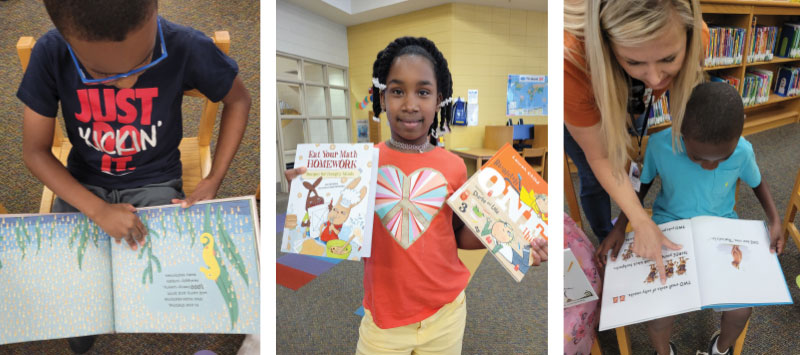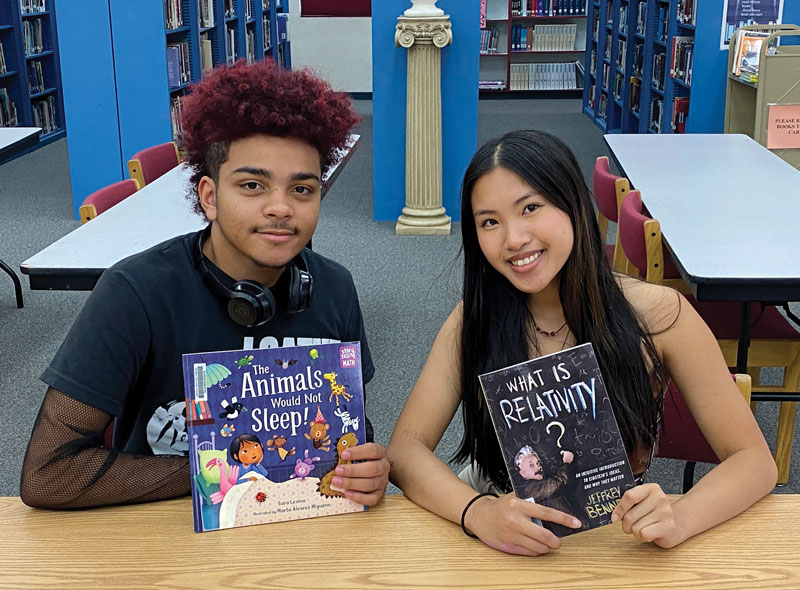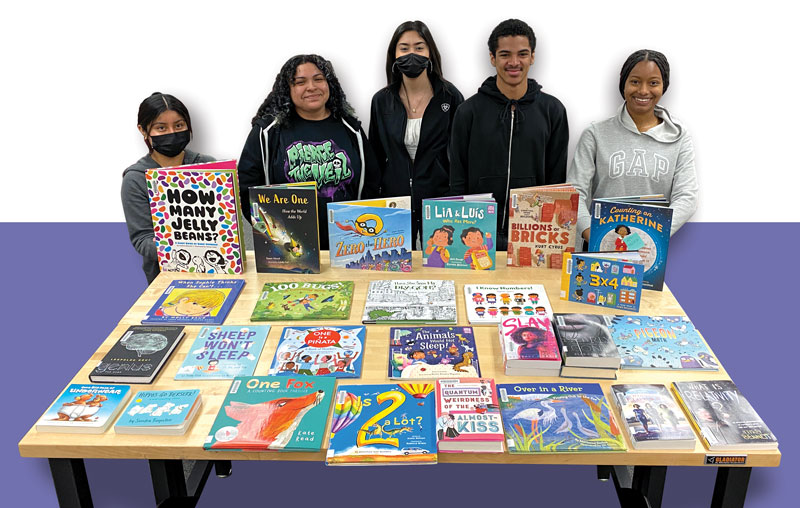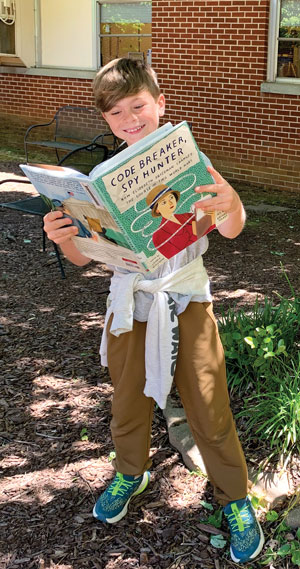Winning Numbers: The Right Books Turn Math Haters into Math Lovers
When kids read engaging stories about math, they learn to love it. That’s the idea behind the Mathical Collection Development Awards, and school librarians who have received the award say that’s exactly what happens.
 |
Michelle Barnett’s students at Providence (AL) Elementary School, which won a 2022 Mathical AwardLeft and center photos by Michelle Barnett, right photo of Barnett with student by Susan Gautreaux |
How do you prevent students from developing a fear of math? With a great book, librarians have found.
When kids read engaging stories about math, they learn to love it. That’s the idea behind the annual Mathical Collection Development Awards, and school librarians who have received the award say that’s exactly what happens.
The Mathical Collection Development Awards, presented by the Simons Laufer Mathematical Sciences Institute, in partnership with SLJ, currently provide grants of $850 to selected libraries in Title 1 K–12 schools to buy fiction and nonfiction titles that have won the Mathical Book Prize for inspiring a love of math in the everyday world.
 |
Students from Central East High School in Fresno, CAPhoto by Christine Flores |
With titles ranging from picture books to YA novels, the books present mathematical and STEM concepts in a fun, engaging, and accessible way, and many also teach students about historical figures in math and science.
Librarians have used Mathical grants to supplement their story times and introduce math lessons, revamp their collections and draw more students to the library.
“I see kids at the high school level [saying] ‘I hate math.’ That starts somewhere, where they think they can’t be good at math,” says Christine Flores, librarian at Central East High School Library in Fresno, CA, which won the award in 2022.
Julie Poole had a similar experience with nontraditional adult students she has taught, who were “just terrified of math.” Their fear made Poole think something must have gone wrong with their math instruction early on.
So Poole takes a math-friendly approach with her own students. “What better place to start with that than with kids, showing them that math is fun and it’s everywhere?” says the media center paraprofessional at Milford (GA) Elementary School, which won the grant in 2023.
Since Poole started at Milford two years ago, she says, “I have put math into almost every single lesson plan,” she says. When she learned about the Mathical award, she thought, “Wow, this is my award. It’s been waiting on me to apply.”
 |
Students from Central East High School in Fresno, CAPhoto by Christine Flores |
One award, many applications
Librarians find multiple ways to put the Mathical books they purchase to good use. Michelle Barnett, library media specialist at Providence (AL) Elementary School, does a lot of STEM activities in the library, including lessons with pattern blocks and geoboards, to support often time-strapped teachers. Since receiving the Mathical grant in 2022, she has used the books to reinforce teachers’ lessons.
Barnett chose picture books for a reason, when she noticed that after COVID, “Our student body is just not reading longer chapter books like I would like to see happen,” she says.
When Barnett reads When Sophie Thinks She Can’t... by Molly Bang to fourth graders, she shows them how to use tangrams as a way to learn fractions.
Barnett also visits classrooms to present titles, since “I think books do better when you book-talk them,” she says. In particular, the “Secret Coders” graphic novel series by Gene Luen Yang and Mike Holmes, and The Miscalculations of Lightning Girl by Stacy McAnulty, have caught on with older readers.
Using a math book to teach a lesson also helps reinforce the Alabama math standards, Barnett adds. “Putting in for the grant helped boost what I was already trying to do and just gave it a little more impetus.”
After using Mathical grant books for collection development and lesson planning, Barnett has started speaking on the topic at the district, state, and national levels—most recently, presenting an IdeaLab at the 2023 American Association of School Librarians conference.
Flores mainly uses the books for her literacy outreach programs, which pair high school students with younger learners. In her Kinder Tech Buddies program, English-language learners (ELLs) read books digitally to kindergarten students. For Athletes as Readers and Leaders, high school athletes visit elementary schools to read to students about athletics-focused topics, such as eating healthy or being a good team player. Mathical titles like Lia & Luis: Who Has More?, a book about comparisons by Ana Crespo, illustrated by Giovana Medeiros, work well in both programs, she says.
Flores also uses picture books, such as Counting on Katherine: How Katherine Johnson Saved Apollo 13, by Helaine Becker, illustrated by Dow Phumiruk, to help older readers learn about the history of math concepts. Elementary school librarians have added some of the titles she’s using to their own collections, she adds, including Hippos Go Berserk!by Sandra Boynton , Billions of Bricks by Kurt Cyrus, and Goodnight, Numbers by Danica McKellar, illustrated by Alicia Padrón. “I don’t think they would’ve been on the radar of some of those elementary librarians” if not for her programs, she says.
Poole had lesson plans ready for nearly all books she bought, many based on suggestions from publishers’ and authors’ websites. She read One Is a Piñata: A Book of Numbers , by Roseanne Greenfield Thong, illustrated by John Parra, with special needs pre-K to fifth graders. Poole’s school also has a large Hispanic population, including many ELLs, so “anything that I can read to the kids that integrates Spanish helps,” she says.
“We take the same book and scaffold it up with the different grade levels,” Poole says. “Some of the books that I bought for lower level are actually working quite well for upper level.”
Poole read One Big Pair of Underwearby Laura Gehl, illustrated by Tom Lichtenheld, with third graders to introduce division; students then drew pictures about remainders. During Women’s History Month, she will have students read biographies of female mathematicians and scientists and win prizes for writing book reviews. And Poole used Bird Count by Susan Edwards Richmond, illustrated by Stephanie Fizer Coleman, about the National Audubon Society’s annual Christmas Bird Count, to encourage the whole school to participate in the event.
 |
Milford (GA) Elementary School student enjoys a math-themed book.Photo by Julie Poole |
Fan favorites
Mathical books have become the most checked-out books in the library at Cassie Mendez’s library in the Washington Unified School District (CA). The library technician, who earned the award for her school in 2023, says that popular titles include Billions of Bricks, Bird Count, “Secret Coders,” Pigeon Math by Asia Citro, illustrated by Richard Watson; and Unusual Chickens for the Exceptional Poultry Farmerby Kelly Jones, illustrated by Katie Kath.
Mendez made slides with math facts to show to young students readingLemonade in Winterby Emily Jenkins, illustrated by G. Brian Karas.
Since receiving the grant in 2021, Misti Sikes, media specialist at K.B. Sutton Elementary School in Georgia, has used the books for story times and discussing math principles, such as different shapes in Which One Doesn’t Belong? by Christopher Danielson or counting fruits and other items in Baby Goes to Market by Atinuke, illustrated by Angela Brooksbank.
“We used tally marks as we went throughout the story,” she says. She has also used a “count the jewels” math game after reading counting books, in which a pair of students is given seven “jewels” to divide up. Each takes one or two at a time during turns, competing to see who will take the last one. School events such as Family Math Nights allow parents and students to “read while they eat” and do activities, such as using toothpicks and marshmallows to build a structure strong enough to hold the book Just the Right Size by Bonnie Grubman, illustrated by Suzanne Diederen.
Student favorites include How Many Jelly Beans? by Andrea Menotti, illustrated by Yancey Labat, Sikes says. “It is so well loved it’s about to fall apart. It really helps them understand how many jelly beans it takes to make a million.”
Renee Parker, library media specialist at Selinsgrove (PA) Intermediate School, which received the award in 2023, says books she bought are for classroom use. Parker is creating a spreadsheet so teachers know “what concepts are addressed with each text,” she says.
This spring, Parker will pair the books with activities, “either coding or building and designing and creating.” When they read Too Many Pigs and One Big Bad Wolf by Davide Cali, illustrated by Marianna Balducci, for instance, students will build a house with materials like magnetic sticks and blocks.
Sikes used the grant to buy more than 40 titles, including Zero Zebras by Bruce Goldstone, illustrated by Julien Chung and Hedy Lamarr’s Double Life by Laurie Wallmark, illustrated by Katy Wu.
Parker, a former classroom teacher who uses STEM in her curriculum, is already planning ways to use the books for next year and wants to promote them to librarians at other schools.
For Michele Tota, librarian at Farrell Area (PA) High School, receiving the award in 2022 helped her rebuild the library’s collection. There was no school librarian for about 12 years, so when she started three years ago, “I just started pulling books.” Many were outdated, and she wanted newer titles about numbers or STEM for students who don’t like reading. When she received the grant, “I ran around and shared everything with everyone, like, ‘Look guys, we did this!’”
The school’s book club read one of her purchases, Slay, by Brittney Morris. Otherwise, the books are in math teachers’ classroom collections or in the library. Particular hits include AfterMath by Emily Barth Isler, “Genius” by Leopoldo Gout, and The Quantum Weirdness of the Almost-Kiss by Amy Noelle Parks . Tota adds that the Mathical award enticed students to come into the library who hadn’t before. “That was the big deal, just to get them to come here,” she says.
As Poole has been introducing the Mathical books to students, she has been helping them see math differently. “We had the kids draw what they were passionate about.… I was really shocked by how many kids chose math as their passion,” she says. As for the math haters, “we’ll read a book and I’ll ask them some questions, and I’ll tell them, ‘Hey, you’re doing math right now and you seem to be having fun. What do you think about math now?’ I’m changing hearts and minds.”
Marlaina Cockcroft is a writer and editor.
|
Stay tuned for information about the next round of Mathical awards. |
RELATED
The job outlook in 2030: Librarians will be in demand
The job outlook in 2030: Librarians will be in demand
ALREADY A SUBSCRIBER? LOG IN
We are currently offering this content for free. Sign up now to activate your personal profile, where you can save articles for future viewing






Add Comment :-
Be the first reader to comment.
Comment Policy:
Comment should not be empty !!!